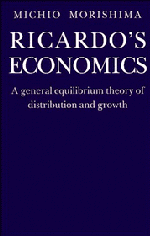4 - The equal rate of profit and exploitation
Published online by Cambridge University Press: 01 June 2011
Summary
1 It has been seen that Ricardo's economics consists of various parts – the price–cost equations, the demand–supply equations for factors (capital services and labour), the marginal productivity equations for land, etc. – which together form a system of general equilibrium. Moreover, these parts cannot stand independently but are interrelated. For example, it is only in exceptional cases that we can derive the wage–profit frontier from the price–cost equations alone; our derivation of the frontier in the previous chapters, to say nothing of Sraffa's own derivation, is misleading because it is confined to the realm of exceptional cases assuming no joint output etc. In this chapter I shall show that parts of the Ricardian model are interlinked by certain rules, such as that of dual cross adjustment, and in doing so I shall elaborate my argument of Section 6 of the last chapter. I also shall take this opportunity to correct the misunderstanding which Roemer and Petri have with regard to my Generalized Fundamental Marxian Theorem, its validity being warranted where the dual cross adjustment mechanism of the Ricardo–Marx–Walras type works. I shall furthermore be concerned with the assertion of Schumpeter, Samuelson and many other economists, that the labour theory of value should be extended to a multi-factor (say, land and labour) theory of value, which is also due to their misunderstanding of Ricardo and Marx. This has partly been discussed in the previous chapter and will be reexamined below to complete the argument.
- Type
- Chapter
- Information
- Ricardo's EconomicsA General Equilibrium Theory of Distribution and Growth, pp. 81 - 100Publisher: Cambridge University PressPrint publication year: 1989



